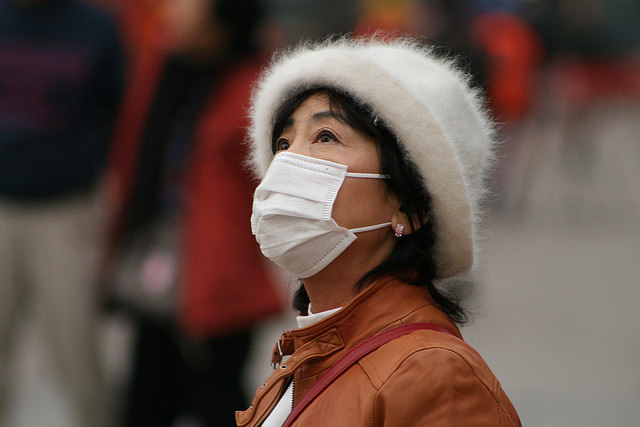
A great “air pollution blindspot stretching the length of Africa, across large parts of the former Soviet Union, south-east Asia and the Caribbean,” is affecting 1 billion people, according to a new analysis by the Guardian.
According to data released by the World Health Organization, as many as 92 countries do not have the monitoring equipment or staff needed to measure particulate matter (PM). Meanwhile, 33 additional countries including Indonesia, Egypt and Russia monitor just one or two of its cities.
The global air pollution ‘blindspot’ affecting 1 billion people https://t.co/u8dFs2fP5Y
— Guardian Environment (@guardianeco) May 17, 2016
“According to the latest urban air quality database, 98% of cities in low- and middle income countries with more than 100 000 inhabitants do not meet WHO air quality guidelines,” writes the report.
It is estimated that outdoor air pollution kills 3.3 million people every year, a figure which is expected to rise with rapid increase of air pollution. As we reported earlier this month, global air pollution levels have risen by as much as 8 percent in just five years.
“Air pollution is a major cause of disease and death. It is good news that more cities are stepping up to monitor air quality, so when they take actions to improve it they have a benchmark,” says Dr Flavia Bustreo, WHO Assistant-Director General, Family, Women and Children’s Health. “When dirty air blankets our cities the most vulnerable urban populations—the youngest, oldest and poorest—are the most impacted.”
However, encouraging evidence that suggests many cities in are successfully addressing air pollution levels. In just 5 years, more than half of the monitored cities in high-income countries and more than one-third of those in low- and middle-income countries reduced their air pollution levels by more than 5%, according to the WHO data.
“The cities which have invested in the capacity to regularly monitor and report the local air quality measurements have already demonstrated a commitment to starting to address air quality issues and public health,” said a WHO spokeswoman.
In comparison, a large percentage of low-income and poorly governed countries do not monitor air pollution levels in their cities. As many as 35 of the world’s 50 poorest countries, are not monitoring the air in any of their cities. As a result, it is likely that many of these cities are breaching global and national standards, which is ultimately putting lives at risk.
In Africa, just 10 of the continent’s 54 countries are monitoring pollution levels. 1.3% of the cities where WHO records air quality are located in Africa – a very disturbing statistic, since the continent is home to 16% of the global population.
Yet despite the clear link between air pollution monitoring and to low-income countries, it appears poorly governed countries are also among those who neglect this pressing issue. As many as 36 out of the 51 countries the Economist Intelligence Unit’s (EIU) democracy index labels as “authoritarian”.
In Russia, for example, which is home to thousands of towns and cities, Moscow is the only city that records air quality in the country. However, public information about air pollution can force the governments of countries where democratic freedom is limited to finally make a change.
In China, a number of control measure were put into place after the public grew concerned for their safety after the U.S. Embassy released air quality data in Beijing. Since the changes, including the closure of coal power stations and steelworks, air pollution has reduced in some of China’s most polluted cities.
In fact, China increased the number of cities monitoring air pollution form 111 to 210 in just two years. This trend is also evident across the rest of the world. In 2014, a total of 1,622 cities were being monitored. Today, that number has increased to 2,974 cities.
According to the UN Environment Programme, setting up a single monitoring station currently costs around $150,000-2000,000, not including ongoing staff and maintenance costs. With the use of new technology, it is hoped that the monitoring stations will become more affordable.
Due to the high costs associated with monitoring stations, high-risk areas have become the highest priority. In West Africa, as much as 96% of the population lives above the WHO guidelines, according to a satellite study. However, it is also important to note that satellite observations are known for being inexact.
“Satellite remote sensing offers a global observation source to fill that monitoring gap,” said Professor Randall Martin, head of the Spartan project, an emerging global particulate matter network.
As a result of the measures being taken by both citizens and governments around the world, the air pollution blindspot is reducing in size. Only time will tell if governments and societies continue to push for these measures, and ultimately reduce the levels of air pollution in cities worldwide.
Image: Flickr, Nicolò Lazzati
You want to support Anonymous Independent & Investigative News? Please, follow us on Twitter: Follow @AnonymousNewsHQ
This article (1 Billion People Are Living in a Great Air Pollution ‘Blindspot’) is a free and open source. You have permission to republish this article under a Creative Commons license with attribution to the author and AnonHQ.com.




